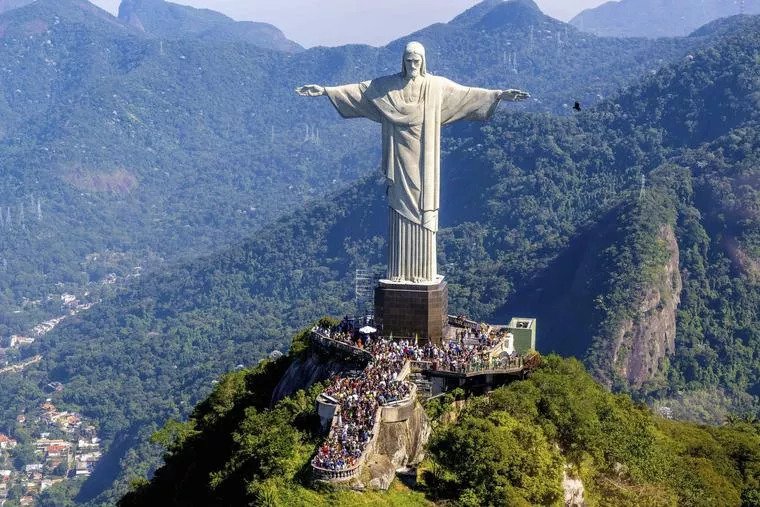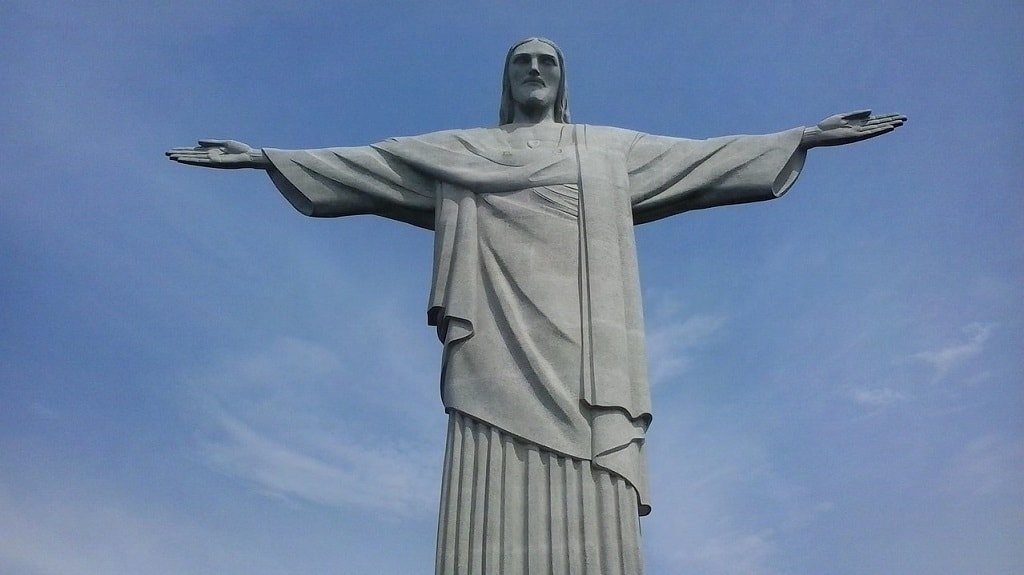Top 37 Unknown and Interesting Facts About Christ The Redeemer Statue
One of the most recognizable structures in the world and a representation of Brazilian culture and Christianity is the Christ the Redeemer Statue in Rio de Janeiro, Brazil. The statue, which is 98 feet tall and 92 feet across, is situated atop Mount Corcovado. With its arms extended, this enormous figure seems to envelop the city below, signifying harmony and embracing individuals from various backgrounds. Since its completion in 1931, it has gained international recognition as a symbol of architecture, art, and faith.

Pedro Maria Boss, a Catholic priest, first suggested the statue’s design in the 1850s, but the Catholic Circle of Rio didn’t begin accumulating money for the monument until 1921. French artist Paul Landowski sculpted the statue, which was designed by Brazilian engineer Heitor da Silva Costa. The statue was built in Brazil using soapstone, which is renowned for its flawless finish and durability, and reinforced concrete after the head and hands were shipped there from France.
Constructed to endure the severe weather on Corcovado, the statue is widely hailed as a technical marvel. Its importance as a cultural and religious landmark was highlighted in 2007 when it was named one of the New Seven Wonders of the World. Millions of pilgrims and visitors visit Christ the Redeemer each year, drawn by its magnificent architecture as well as its breath-taking panoramic vistas of Rio de Janeiro, which include the Maracana Stadium, Sugarloaf Mountain, and Copacabana Beach.
Beyond its feats of engineering and architecture, Christ the Redeemer is a deeply symbolic building for Christians, representing hope, redemption, and the resilient spirit of the Brazilian people. It is one of the most photographed sculptures in the world and a symbol of peace and harmony since its image has appeared in movies, artwork, and photographs.
This article will provide you with 50 unknown and interesting facts about Christ the Redeemer that you probably didn’t know!
1. It Stands 98 Feet Tall
The Christ the Redeemer statue stands 98 feet (30 meters) tall. However, when measured from the base to the top of the statue’s outstretched arms, the total height reaches 125 feet (38 meters).
2. Its Arm Span Is 92 Feet
The statue’s arms stretch a vast 92 feet (28 meters) from fingertip to fingertip, giving it an imposing presence over the city of Rio de Janeiro. This wide span is symbolic of Christ’s embrace of the world.
3. It Was Finished in 1931
The construction of Christ the Redeemer began in 1922 and was completed in 1931. It took nearly nine years to complete the statue, involving a mixture of religious devotion, engineering ingenuity, and skilled craftsmanship.
4. Made of Soapstone and Concrete
The outer shell of Christ the Redeemer is made from soapstone, a material known for its durability and resistance to weathering. The internal structure is built from reinforced concrete, which adds strength and stability to the towering figure.
5. Weighs Over 700 Tons
The Christ the Redeemer statue is not only tall but also incredibly heavy. It weighs approximately 700 tons (635,000 kilograms), which makes it one of the heaviest statues of its kind.
6. Designed by Heitor da Silva Costa
The design of the statue was created by Brazilian engineer Heitor da Silva Costa, who envisioned a Christ figure that would be both imposing and graceful. His idea of having Christ’s arms open wide as if embracing the world was intended to express love and compassion.
7. The Sculptor Was French
The sculptor responsible for bringing da Silva Costa’s design to life was French artist Paul Landowski. Landowski worked with a team of artisans to create the detailed features and the intricate form of the statue.
8. Constructed With International Collaboration
Although the design was Brazilian, the construction involved an international effort. The concrete was supplied by a French company, and the soapstone that covered the statue came from Italy.
9. Funded by Brazilian Catholics
The creation of Christ the Redeemer was funded primarily by Brazilian Catholics, who organized a massive fundraising campaign to raise the necessary funds for the statue’s construction.
10. Originally Meant to Be a Catholic Monument
The idea behind the Christ the Redeemer statue was initially conceived to be a Catholic religious symbol, to mark the centenary of Brazil’s independence in 1922. Its purpose was to solidify Catholicism’s prominence in the country.
11. It Has Survived Many Storms
One of the most impressive feats of Christ the Redeemer is its resilience. Despite being exposed to harsh weather conditions like strong winds, heavy rains, and lightning, the statue has withstood it all for nearly 100 years.
12. A Symbol of Rio de Janeiro
Over time, the statue has evolved from a religious monument to a cultural and national symbol of Brazil. It is often used in tourist campaigns and represents the warm spirit of Rio de Janeiro.
13. Considered One of the New Seven Wonders of the World
In 2007, Christ the Redeemer was named one of the New Seven Wonders of the World in a global poll organized by the Swiss-based New7Wonders Foundation. This recognition increased the monument’s visibility and cemented its place as one of the world’s most famous landmarks.
14. Located in a National Park
Christ the Redeemer is located in the Tijuca National Park, which is one of the largest urban forests in the world. The park is home to a variety of flora and fauna, making the area surrounding the statue a rich natural environment.
15. Accessible via Train or Foot
There are two main ways to reach Christ the Redeemer: by a scenic train ride that takes you through the lush rainforest of the Tijuca Forest or by hiking up the mountain to the top.
16. Lighting the Statue
At night, the statue is illuminated with powerful lights that make it visible from many parts of Rio. These lights are carefully maintained to ensure that the statue can be seen from as far as 20 miles away on clear nights.
17. Restoration Projects
Over the years, Christ the Redeemer has undergone several restoration projects. In 2010, the statue underwent a major restoration to repair weathering and ensure its continued preservation.
18. The Original Idea Was for a Smaller Statue
Initially, the proposal was to build a much smaller statue of Christ. However, it was later decided that a grander, more imposing figure would be more fitting for such an important landmark.

19. The Heart of Christ is a Symbol of Love
The heart of the Christ figure is depicted as being full of love and compassion for all mankind. This symbolic heart represents the kindness and mercy that is at the core of Christianity.
20. It Has Been a Popular Movie Star
Christ the Redeemer has appeared in several films, documentaries, and music videos. Its imposing figure has been used to evoke feelings of awe and reverence in cinematic scenes.
21. Symbolizes Peace and Unity
The outstretched arms of the statue represent Christ’s embrace of all people, no matter their nationality, religion, or background. It is a universal symbol of peace and unity.
22. Christ the Redeemer Faces the City of Rio
The statue faces the city of Rio de Janeiro, with its arms spread wide as if embracing the people below. This positioning emphasizes the statue’s role as a guardian and protector of the city.
23. Christ the Redeemer Was Originally Controversial
When the idea of building Christ the Redeemer was first proposed, it was met with some resistance. Many people were skeptical about the cost and the practicality of such a monumental project, but the statue eventually won over critics.
24. The Statue Was Unveiled on October 12, 1931
Christ the Redeemer was officially unveiled to the public on October 12, 1931, in a grand ceremony that attracted thousands of people. The statue’s opening was a significant event in Brazil’s religious and cultural history.
25. The First Lightning Strike in 2008
In 2008, Christ the Redeemer was struck by lightning, causing damage to the statue’s right hand. Fortunately, the statue was repaired quickly and has remained intact since.
26. Made with a Combination of Materials
Christ the Redeemer is constructed from a combination of materials, including soapstone, concrete, and steel. The materials were chosen for their durability and ability to withstand the elements.
27. Symbol of Brazilian Faith
For Brazilians, Christ the Redeemer is much more than just a tourist attraction—it is a symbol of faith, national pride, and cultural identity. It represents the country’s deep Catholic roots and the unity of its people.
28. One of the Largest Art Deco Statues
Christ the Redeemer is one of the largest Art Deco statues in the world. The style was popular in the early 20th century, and it is characterized by geometric shapes, clean lines, and a sense of symmetry.
29. A Global Pilgrimage Site
People from all over the world travel to Rio de Janeiro to visit the Christ the Redeemer statue. It is one of the most visited tourist destinations in the world, with millions of visitors each year.
30. Visitors Can Experience a 360-Degree View
Once at the summit, visitors to Christ the Redeemer can enjoy a breathtaking 360-degree panoramic view of Rio de Janeiro, including its beaches, mountains, and the iconic Sugarloaf Mountain.
31. The Original Model Was Smaller
Before the full-scale statue was built, a smaller model of Christ the Redeemer was crafted to test proportions and visual impact. The original model is now housed in the city of Rio de Janeiro.
32. Symbol of Catholicism
Christ the Redeemer remains an enduring symbol of Catholicism in Brazil. The statue is often used in religious celebrations, including Masses and processions, especially during Holy Week and Christmas.
33. The Statue Was Never Part of a Religious Order
Although the statue is deeply religious, it was never directly affiliated with a particular religious order or church. Instead, it was conceived as a secular symbol for all Catholics.
34. The Statue Was Not Designed to Be a Monument to Jesus Alone
While the statue represents Christ, it was also intended as a symbol of Christianity in Brazil and an expression of faith to the world. It was meant to symbolize all of humanity’s relationship with God.
35. A Major Engineering Feat
Building a statue of this scale on top of Corcovado Mountain was an incredible engineering challenge. The designers and engineers had to contend with a rocky, difficult terrain and unpredictable weather.
36. Christ the Redeemer Is Part of Rio’s Skyline
The statue is part of the iconic skyline of Rio de Janeiro, providing a backdrop for the city’s famous beaches and festive celebrations, including Carnival.
37. The Statue’s Outstretched Arms Are Meant to Convey Compassion
The open arms of Christ the Redeemer are meant to symbolize Christ’s compassion and acceptance of humanity. The statue’s pose is reminiscent of the welcoming gesture of Christ in Christian art.

